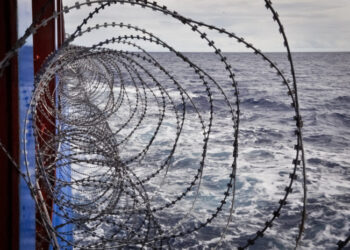With a laser attached, the idea is to blast multiple skiffs more efficiently
 Now we know what the Navy plans to do with its experimental hybrid of laser cannon and machine gun: zap pirate ships.
Now we know what the Navy plans to do with its experimental hybrid of laser cannon and machine gun: zap pirate ships.
Two defense giants, Boeing and BAE Systems, announced late last month that they would team up on a $2.8 million Navy contract for a prototype version of BAE’s Mk-38 25-mm machine gun with a little upgrade: a death ray. As the companies excitedly explained, the new gun would protect surface ships from pretty much everything, from enemy boats to small drones.
What the companies weren’t letting on was that they had already tested the machine-laser-gun a month before the announcement. And in tests that BAE – hardly an uninterested party – claims were successful, the new Mk-38 took on its most likely adversary: pirate skiffs.
In late June, the waters of the Choctawatchee Bay near Florida’s Elgin Air Force Base stood in for the Gulf of Aden, asersatz pirate ships “swarmed” amidst dense “civilian” maritime trafficto harass a mock Navy “platform” armed with the laser gun. The enhanced version of the Mk-38 used its lasers to fix the enemy targets for bursts of machine gun fire, before switching up to laser mode to “defeat the targets” with a “high beam-quality 10-kilowatt laser,” BAE spokeswoman Stephanie Bissell Serkhoshian told Danger Room.
That might be the most practical use for the new weapon. Pirate attacks near Yemen and Somalia employ motorboats, often working in “swarm” teams, small enough to be neutralized by 10 kilowatts’ worth of power, which the Navy considers about an order of magnitude below what’s typically militarily useful. They also get close enough to U.S. ships and merchant vessels to let off small-arms fire at the crews, putting them in range of either the machine-gun bursts or the laser target.
Serkhoshian pointed to an April pirate attempt on the USS Ashland as a template for the test. In the Gulf of Aden on April 10, a green pirate skiff sneaked up on the amphibious dock landing ship, getting close enough for its six-man crew to let off small-arms fire at the Ashland. The U.S. sailors retaliated with their laser-free Mk-38, setting the skiff aflame and forcing the pirates to abandon ship.
With a laser attached, the idea is to blast multiple skiffs more efficiently: A laser of similar kilowatt expenditure can burn through an outboard motor in about a minute, as the Office of Naval Research demonstrated with a different laser system in the California seas back in April.
And it’s also useful for locking onto targets for the conventional machine gun to shoot. It’s certainly a departure from BAE’s last anti-piracy contribution: a crystalline neodymium-yttrium-aluminium garnet laser used as a blinding floodlight.
Still, the test had some serious training wheels attached. The laser version of the Mk-38 wasn’t fired from a Navy ship maneuvering against the enemy skiffs. It was actually affixed to a Navy “platform” on dry land, Serkhoshian confirms, while the skiffs were out in the water. It’s much easier to fire from a static position, and Navy ships like the Ashland probably won’t have that luxury.
By contrast, the Office of Naval Research’s laser test in April was a big deal precisely because it represented the first time a Navy laser fired from a ship speeding through choppy waters blasted away a moving target. Additionally, BAE won’t disclose how far away the “pirate skiffs” were when the Mk-38 took them out.
It’ll be years before the Mk-38 gets out of the development stage and aboard a ship. But the eternal struggle between pirates and lasers just intensified.
Source: Wired





























































